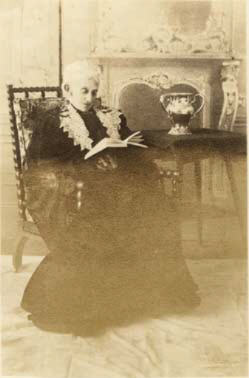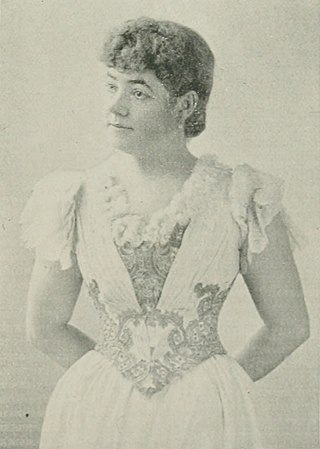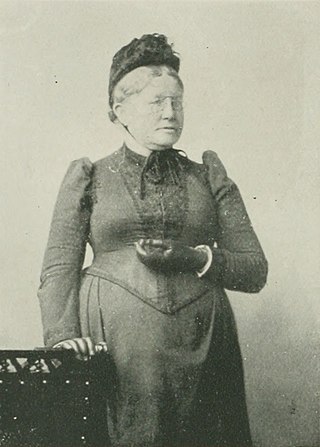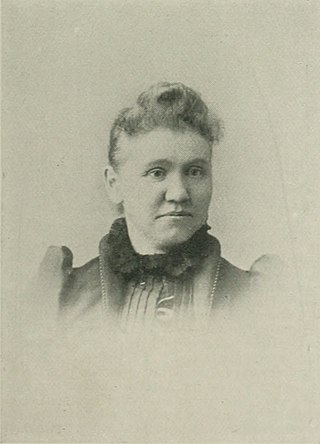
Belle R. Harrison (1856-1940) was a poet and short story author of the American South, [1] as well as an educator. [2]

Belle R. Harrison (1856-1940) was a poet and short story author of the American South, [1] as well as an educator. [2]
Lucy Belle Richardson was born October 20, 1856, at Camden, Alabama. She was the daughter of Professor Warfield Creath Richardson [3] (1823-1914) and Catherine Cole (Jones) Richardson (1833-1911). [1] Her siblings were Clement (b. 1859) and Ida (b. 1861). [4] She was educated at Stafford school and the Tuscaloosa female college. [1]
Harrison was the author of, Poems, 1898, [1] as well as a collection of negro short stories. [5] She was a Methodist and a member of the United Daughters of the Confederacy. [1] Harrison served as president of the Kettledrum Club of Tuscaloosa. [6]
On July 21, 1881, she married John Calhoun Harrison, of Tuscaloosa. They resided in that city. [1] Their children were Katie (b. 1882) and Adeline (b. 1888). [4] Belle R. Harrison died in Tuscaloosa, December 4, 1940. [5]
The Belle R. Harrison Literary Society was named in her honor. [7]

Amelia Gayle Gorgas was librarian and postmaster of the University of Alabama for 25 years until her retirement at the age of eighty in 1907. She expanded the library from 6,000 to 20,000 volumes. The primary library at the university is named after her. A native of Greensboro, Alabama, Amelia was the daughter of Alabama governor John Gayle, the wife of Pennsylvania-born Confederate general Josiah Gorgas and the mother of Surgeon General William C. Gorgas. She was inducted into the Alabama Women's Hall of Fame in 1977.

Mary R. P. Hatch was an American author from New Hampshire. She contributed stories to the Transcript, Mountaineer, Fireside Companion, Chicago Ledger, Frank Leslie's Illustrated Newspaper, Springfield Republican, Granite Monthly, The Writer, and several magazines including the Portland Transcript, The Saturday Evening Post, Peterson's Magazine, as well as other periodicals. Her novels included The Strange Disappearance of Eugene Comstocks, The Bank Tragedy: A Novel, and The Missing Man, among others.

Emma Whitcomb Babcock was an American litterateur and author. She did considerable work as a book reviewer, and contributed to various leading magazines. She was the author of Household Hints, a domestic management guide, and A Mother's Note Book, as well as other works. She was president of The Belles-Lettres club, well known in western Pennsylvania, which founded a public library. Babcock died in 1926.

Elizabeth Willisson Stephen was an American author. Since 1878, she contributed prose and poetry to the northern and southern press. Her poem, "Mine", published in the Gulf Citizen, was characterized as classic in its treatment. With her mother, she was the co-author of The Confessions of Two, a novel.
Belle Caldwell Culbertson was an American author and philanthropist, active in social and religious reforms. She served as president, Woman's Foreign Missionary Society of the Presbytery of Washington City; president, Woman's Inter-Denominational Missionary Union of the District of Columbia; and president, Washington Auxiliary Mission to Lepers. Other positions included: Trustee, Anti-Saloon League; Trustee, International Reform Bureau; vice-president, Mothers' Congress of D.C.; and member, Executive Board, Woman's Christian Temperance Union (W.C.T.U.).

Sarah Lord Bailey was a British-born American elocutionist and teacher of dramatic elocution.

Lucia H. Faxon Additon was an American writer, music teacher, and Woman's Christian Temperance Union (WCTU) official. In addition to being a pioneer in WCTU work on the Pacific Coast, she was known as a leader in philanthropic, education, and religious work. Additon was also a clubwoman, being the founder and president of the Woman's Press Club of Oregon, and State chair of Industrial Relations in the Oregon Federation of Woman's Clubs.

Hester A. Benedict was an American poet and writer. She had a literary reputation in the East before her removal to California where she served as president of the Pacific Coast Women's Press Association in San Francisco. Dickinson's works included, Vesta (1872), Fagots (1895), and Songs En Route (1911). After her second marriage, she retained "Hester A. Benedict" as a literary name, and also used it as a pen name in her second book, but not for the third one.

Julia Knowlton Dyer was an American philanthropist of the long nineteenth century. She was associated for over 40 years with nearly every large philanthropic work started in Boston. Her rare executive ability combined with an even temperament made her a natural leader of large bodies. Dyer was prominently connected with 24 associations, only one of which, the Castilian Club, was purely literary. She was president of the Soldiers' Home in Chelsea, Massachusetts, president and founder of the Woman's Charity Club, a member of the executive boards of the Home for Intemperate Women, the Helping Hand Association, and president of the local branch of the Woman's Christian Temperance Union (W.C.T.U.). For 26 years, she was a manager for the Home for Female Prisoners in Dedham, Massachusetts, and was a life member of The Bostonian Society. The Woman's Charity Club Hospital was started by Dyer, president of the Woman's Charity Club; originally located at 28 Chester Park, a few years later, a more commodious hospital was built on Boston's Parker Hill.

Rev. Emma Pow Bauder was an American evangelist, missionary, reformer, and author. Affiliated with the Church of the United Brethren in Christ in Michigan since 1879, she soon thereafter relocated to the San Francisco Bay Area, where she was also active with the Woman's Christian Temperance Union (W.C.T.U.), the largest women's organization in the U.S. during the Gilded Age.

Christine Nielson Dreier was an American concert and oratorio singer, a contralto of wide range. She was soloist in Chicago's First Presbyterian Church for 18 years. Dreier also performed at the Exposition Universelle and the World's Columbian Exposition.
New York City Federation of Women's Clubs was an American women's organization located in Manhattan, New York. The work of the Federation was done through its 26 committees, embracing all lines of social and educational work. Belle de Rivera was its first president.

Libbie Beach Brown was an American philanthropist. She was well known and influential in temperance affairs and other reform movements, and always affiliated with progressive elements.

Eleanor Churchill Gibbs was an educator from the state of Alabama, who taught in Livingston, Selma, Rome, and Anniston. A writer of the American South, she was also a paid contributor to various periodicals.

Katharine Hopkins Chapman was an author and historian of the American South. Born in the antebellum atmosphere of Selma, transplanted to the booming time of Anniston in its infancy, grafted by marriage into the crude conditions of Bessemer's early days, a frequent visitor to Mobile and Montgomery, Chapman was well equipped to delineate Alabama characters and scenes, and in her stories she depicted life among the well-to-do American Southern people, her first writings being signed "Katharine Hope" in deference for her father's scruples against a woman's name appearing in print except at her marriage or death. By 1921, she had published 89 short stories in leading magazines. A short memoir appeared in The Editor in 1913.
Cola Barr Craig was an author of the American South who wrote short stories and a novel. Also a clubwoman, she served as president of several organizations including the United Daughters of the Confederacy (U.D.C.), the Memorial Association of Selma, Alabama, and United Charities of Selma.
Annie Greene Brown was an author of the American South.
Alabama Federation of Women's Clubs is a state organization composed of women's clubs in Alabama. Established in Birmingham in 1895, and admitted to the General Federation of Women's Clubs (GFWC) on December 26, 1907. Foster House became the official headquarters in 1983.

Alabama Female Institute was one of the earliest educational institutions for women organized in Alabama. It opened in Tuscaloosa, in the fall of 1829, as "Sims' Female Academy". In 1831, it became the "Tuscaloosa Female Academy". The name change to Alabama Female Institute occurred in 1833, and this school was chartered in 1835. It continued to operate until 1873.

Maria Brewster Brooks Stafford (1809–1896) was an American educator.